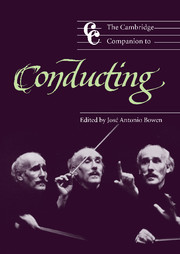Book contents
20 - Managers and the business of conducting
from Part III - Issues
Published online by Cambridge University Press: 28 September 2011
Summary
I started in the business in 1971, at the age of twenty-five, when a well-known US manager told me he was opening a European office. The conductors were not particularly well known, but with youthful enthusiasm I worked night and day for them. I had gathered experience for this largely at the Royal Festival Hall, where, as a student, I always bought the cheapest seats behind the orchestra in order to watch the conductor. Through observation, I came to learn how physical gestures and eye contact conveyed musical structure, excitement, and internal balance to an orchestra. I also collected records of all the major conductors of the past and present, so although I was completely green about managing conductors, I had acquired a system of aural and visual evaluation about the conductor's art. I have experienced the artist/manager relationship, the elements needed to build an artist's career, and the changes to both over the last thirty years. These reflections are offered in the hope that future conductors will be better prepared for what may lie ahead of them.
From impresarios to managers
In the nineteenth century, conductors managed their own careers. Conductors tended to stay in permanent positions for ten to fifteen years or even more. Faster travel opened up more opportunities and created the notion of a conducting “career,” which then led to the need for more administration and planning.
- Type
- Chapter
- Information
- The Cambridge Companion to Conducting , pp. 274 - 285Publisher: Cambridge University PressPrint publication year: 2003

